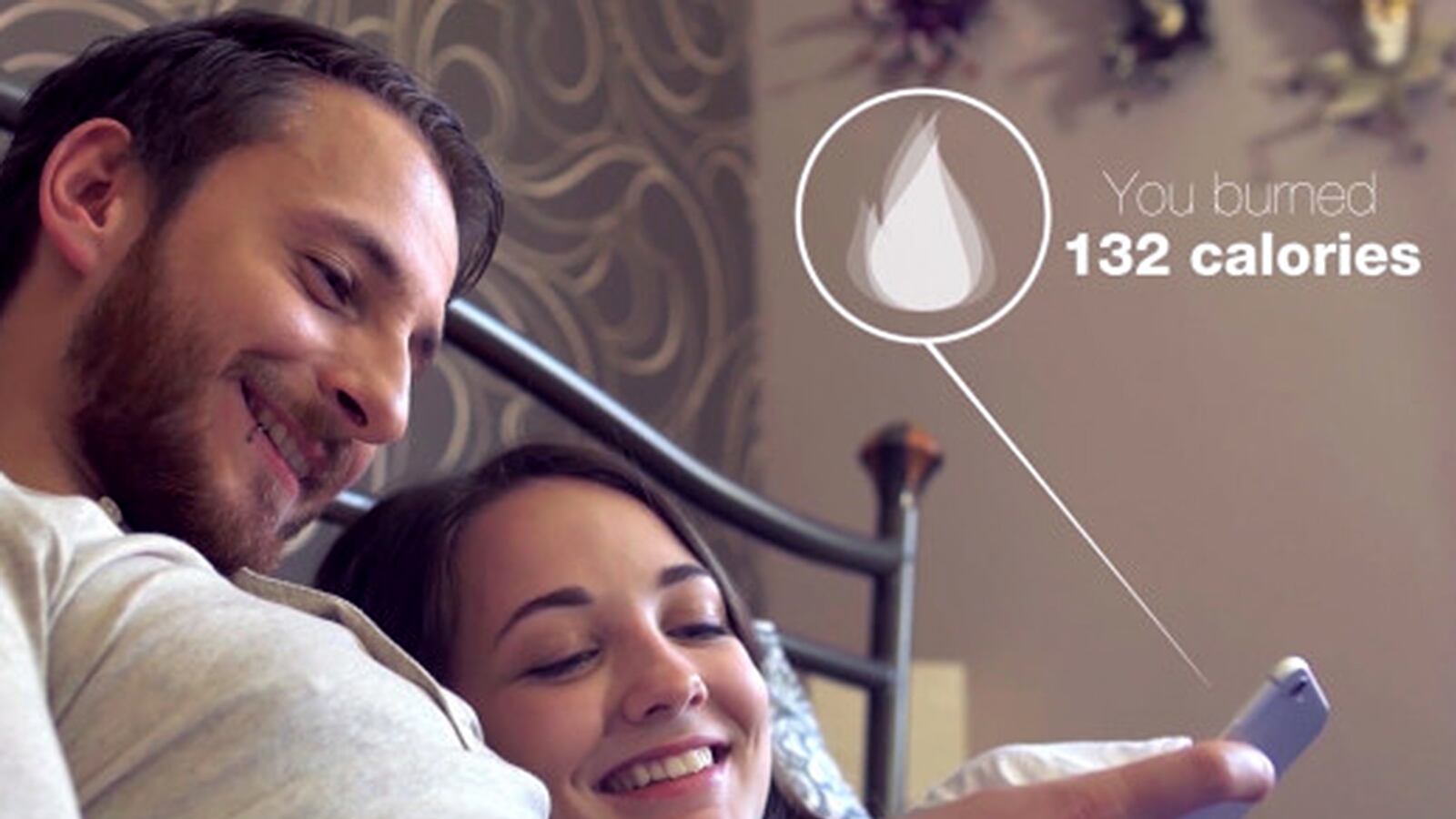“I never have foreplay in person. It’s all through technology. No one is ever with each other. We’re working too hard.”
An array of post-coital thoughts may run through our head as we lie next to our partner in the moments after sex: Do I love him? Did she enjoy it? Are we a “thing” now?
Those were not the kinds of romance-related queries Jakub Konik had.
“One time after I had sex with my girlfriend, I thought, ‘How many calories have I burned?,’” Konik told me.
If your first thoughts after making love are calorically-related, I would normally assume the sex itself was less than satisfying.
But these are the kind of questions one would have if you’re the founder of Lovely, a device that has been billed as the “fitbit for penises.”
Lovely is not yet available for purchase, but its Indiegogo campaign got a fair share of press this week because, well, it’s essentially a cock ring that tracks every quantifiable feature you would want to know about your sexual experience: duration, speed, thrusts, G force, and, yes, calories burned.
Lovely is hardly the first attempt to apply the quantified self movement (the movement to track one’s bodily data with a variety of apps and wearable technology to improve one’s health and wellness) or app technology to glean insights from our sex lives and, more importantly, improve them.
In 2013, Spreadsheets hit the sex app market. It performed an “analysis of coital sounds to track the data of your sex life,” once users “set its calibrations based on the type of mattress you own (inner spring? memory foam?),” measuring “duration, number of thrusts (if applicable), and loudness of sex,” wrote Filipa Ioannou for this publication.
Nipple is another sex tracking app. It’s currently in beta version, and I wrote about it last year. I found the app more silly than sexy, with its way of awarding “points” for sexual activities it deemed exciting or outlandish.
My ultimate conclusion was even the best sex tracking app “will not manage to account for the intangible, indescribable factors that make sexual and romantic experiences enjoyable.”
I’ll confess, a year later, my gut reaction to Lovely is: doesn’t dissecting, breaking down, and quantifying a sexual experience destroy the fun, passion, and excitement of it?
Really, how enticing is it to measure and track every aspect of our sex lives? Moreover, how physically enjoyable is sex when wearable technology is involved?
Konik put me in touch with a couple—a man and a woman—who helped design Lovely and have also been testing it out in their bedroom.
Bearing in mind they may be a little biased, but in an email exchange the male partner swore that “after a few seconds I forget about wearing it.”
The female partner said the “rounded shape with soft apex makes the intercourse extremely pleasant—it massages the clitoris and labia.”
These descriptions actually seemed decidedly unsexy. The more detail in which they broke down the sexual experience with Lovely, the more mechanical the encounter seemed.
Overall, the couple said, “using cocking [Editor’s note: I assume they mean “cock ring”] always makes a difference—intercourse is longer and gives more pleasure.”
The fact that Lovely increases the length of time a man is able to sex with is one of the features played up in promotional materials for device.
However, equating longer sex with better sex is a rather considerable assumption, and one that confirms my suspicions about the soundness of Lovely’s advice (or lack thereof).
Data isn’t only collected during the sexual encounter. The couple fills out a brief survey after the act of coitus, including selecting the sexual position, ranking the experience on a scale of one to five stars, and entering feedback and comments.
“If they had a short duration with strong moves and they said they liked it, we may know they like quickies and we can suggest fun places for them to have quickies,” Konik tells me.
Another example from Konik: “If a couple is looking for a more passionate encounter, Lovely can help build emotional contact, so it will offer positions that enable close eye contact.”
While eye contact certainly can be important for fostering an emotional connection between a couple, at best, these tips are like using toothbrushes scratching at the surface of the massive depths of human sexuality.
When I sent out pleas over social media to find people to speak about their experiences tracking their sex lives with various apps, I only got one response. That may indicate that meticulously counting our orgasms is nowhere near as acceptable as counting our steps, or that for all the buzz sex tracking apps receive, they aren’t actually that great to use.
The one person who did respond was a man who said he and his wife decided to start tracking the number of times they had sex. They entered it into the iPhone calendar from January 1, 2009 through 2013, he said.
Even without fancy, specialized apps or wearables, he said the sheer act of quantifying sex did, in fact, improve their sex lives.
“Honestly, I do think that we had more sex because we were keeping track. If I saw we were under 20 times at the end of the month, I initiated sex,” he said in an email (he asked to remain anonymous). “The amount of sex we had became a reflection of the health of our relationship.”
Dr. Debby Herbenick, an associate professor at Indiana University and researcher at the famed Kinsey Institute, says there certainly can be value in tracking our sexual selves.
“We’re in a new era where people track more of their behavior, including what they eat, how many steps they take, other forms of exercise, and even sex. Wearables and tracking devices can be fun for some people,” she said in an email.
Herbenick sees nothing inherently wrong with this quantifiable sexual self movement, though she does adds a brief note of caution.
“For people interested in sex-related trackables, I’d encourage a sense of fun and exploration rather than feeling like they have to perform or measure up in some way,” she wrote.
In full disclosure, Herbenick has worked on applying some of the data collected at Indiana University to the sex app world.
She collaborated with Graceann Bennett on the development of PlsPlsMe, an app to help sexual partners more openly discuss their desires and fantasies in the boudoir. It is set to launch in September.
“Really bad sex” Bennett says, is what prompted her to design the app, as she recalls the difficulties discussing sex in her former marriage.
“I would go online and search different topics, like ‘how to be turned on.’ It was either too clinical, like going to the doctor, or too pornographic,” she said.
Profiles on PlsPlsMe aren’t public. Partners have to grant each other permission to connect. Then, they answer a series of prompts about their sexual desires, which Bennett refers to as “turn on cards.”
When presented with a physical act—be it cuddling or threesomes—each partner selects whether they “love it, like it, not so much, or no way.”
If both partners select “like it” or “love it,” they get a notification saying they both are into the same turn on.
“You connect and are put in a ‘private chamber’ chatroom, and we give them prompts about how to start a conversation about that shared desire,” said Bennett. The goal is to “help you figure out where you’re both aligned and what you want do sexually.”
For example, if both partners discover they are into blindfolding, they are encouraged to begin a dialogue about who will be blindfolded first.
Yet, once again, the tech-phobic side of me wonders, if you can’t talk face-to-face with your partner about your sexual desires, maybe you don’t have that strong of a connection?
But then Bennett said something that, for better or for worse, is a growing reality of modern romantic relationships.
“I never have foreplay in person. It’s all through technology,” she said. “No one is ever with each other. We’re working too hard.”
We can lament how obsessed we are with staring at our screens, or we can figure out how to harness all that swiping that into sexual anticipation—and in a way that’s a bit more sophisticated than the all-too-ubiquitous sext.
Bennett described the excitement of “being on line in Starbucks and going through the turn on cards. A guy I’m dating answers, and we get a notification that we matched.”
Suddenly, she isn’t just in a Starbucks, but the “’private chamber’ chatroom,” whose interface is all black and gold to evoke a “high-end hotel.”
This sounds utterly ridiculous of course, but PlsPlsMe creates a virtual world of fantasy to help get the juices flowing, so to speak.
“This is not technical. This is about the mental game of foreplay. Anticipation is one of the biggest erotic drives we have,” Bennett said.
Perhaps, although apps and wearables run the risk of turning sex into a chore, an activity as pedantic as counting steps walked to work or calories burned during a squash match. The key is making sure improving sex doesn’t suck the fun out of it.
As Bennett herself told me, “You should never have to work on your sex life. You should play with your sex life.”






